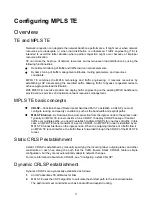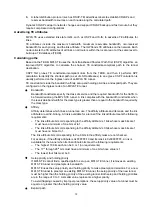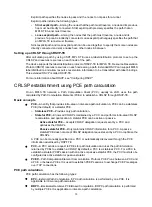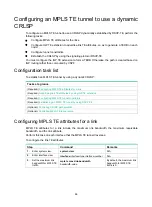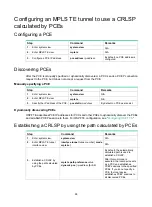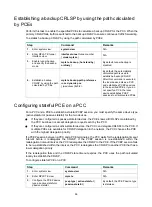
81
How CBTS works
CBTS processes incoming traffic on the device as follows:
1.
Uses a traffic behavior to set a CoS value for the traffic. For more information about traffic
behaviors, see QoS configuration in
ACL and QoS Configuration Guide
.
2.
Compares the CoS of the traffic with the CoSs of the MPLS TE tunnels and forwards the traffic
to a matching tunnel.
MPLS TE tunnel selection rules
CBTS uses the following rules to select an MPLS TE tunnel for the incoming traffic:
•
If the traffic matches an MPLS TE tunnel, CBTS uses this tunnel.
•
If the traffic matches multiple MPLS TE tunnels, CBTS randomly selects a matching tunnel.
•
If the traffic does not match any MPLS TE tunnels, CBTS randomly selects a tunnel from all
tunnels with the lowest priority.
The smaller CoS value, the lower tunnel priority. An MPLS TE tunnel that is not configured with
a CoS has the lowest priority.
CBTS application scenario
As shown in
, CBTS selects MPLS TE tunnels for the incoming traffic as follows:
•
Uses Tunnel 2 to forward traffic with CoS 3.
•
Uses Tunnel 3 to forward traffic with CoS 6.
•
Uses Tunnel 1 to forward traffic with no CoS values.
Figure 32 CBTS application scenario
Protocols and standards
•
RFC 2702,
Requirements for Traffic Engineering Over MPLS
•
RFC 3564,
Requirements for Support of Differentiated Service-aware MPLS Traffic
Engineering
•
RFC 3812,
Multiprotocol Label Switching (MPLS) Traffic Engineering (TE) Management
Information Base (MIB)
•
RFC 4124,
Protocol Extensions for Support of Diffserv-aware MPLS Traffic Engineering
•
RFC 4125,
Maximum Allocation Bandwidth Constraints Model for Diffserv-aware MPLS Traffic
Engineering
•
RFC 4127,
Russian Dolls Bandwidth Constraints Model for Diffserv-aware MPLS Traffic
Engineering





